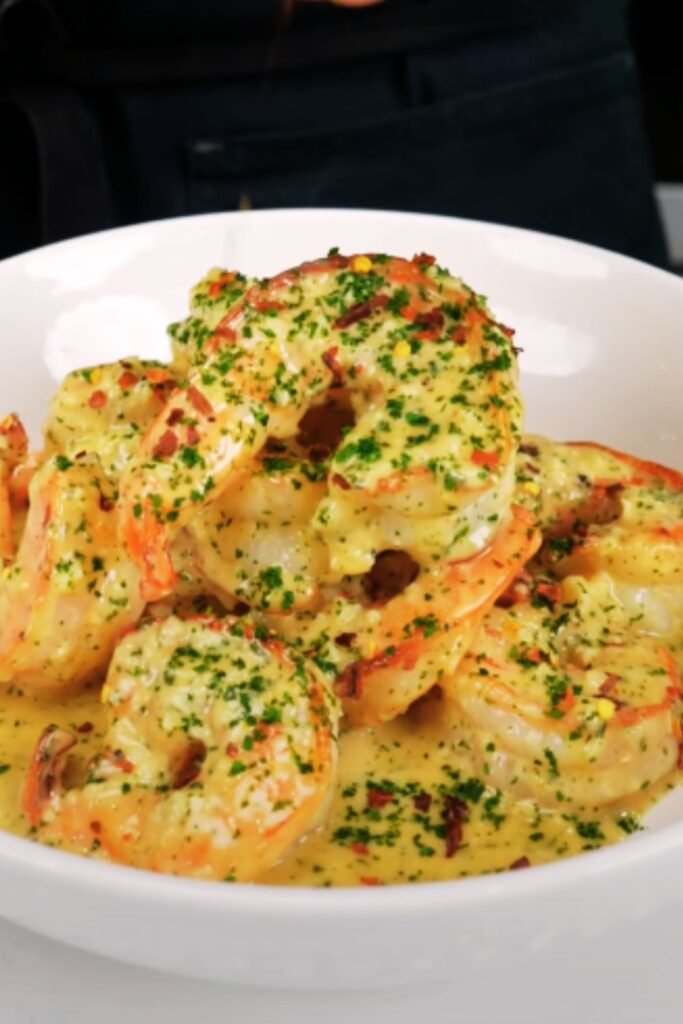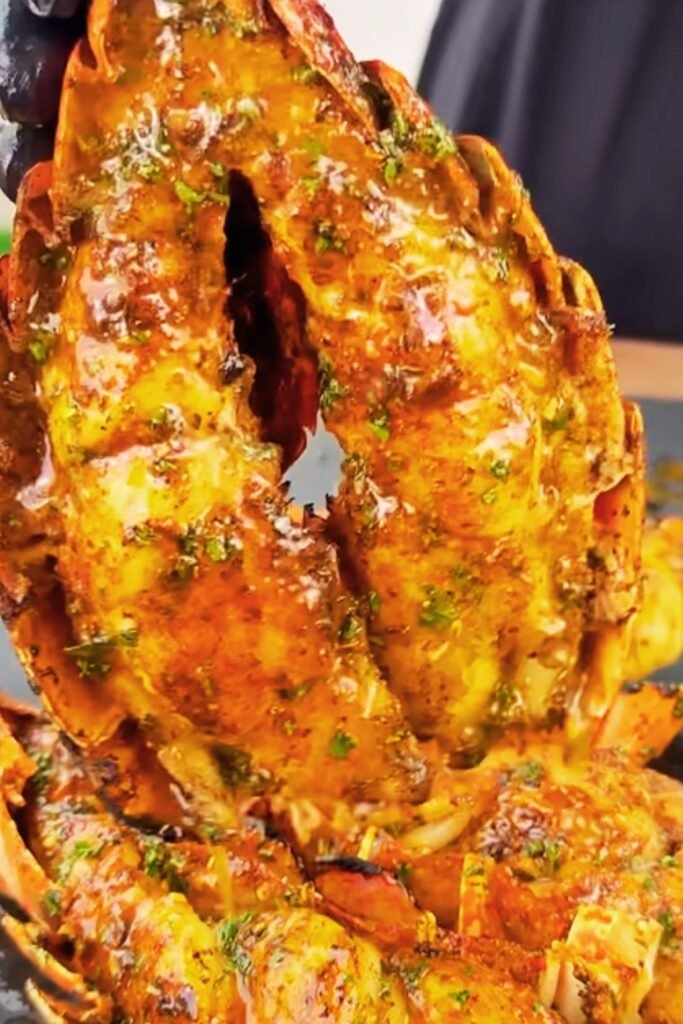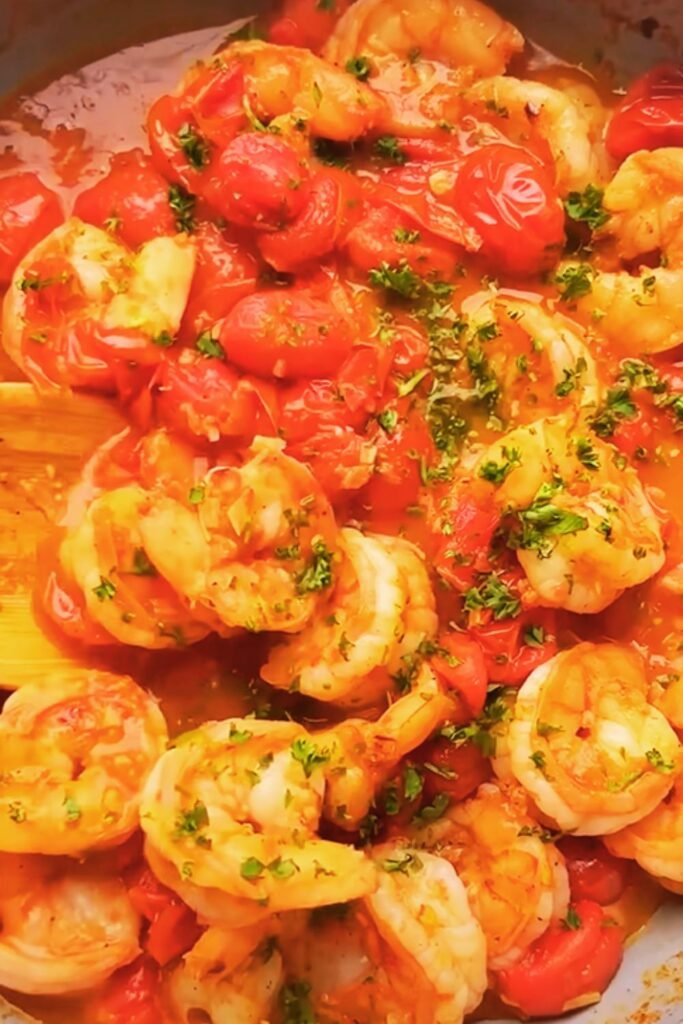There’s something magical about the sizzle of plump shrimp hitting a hot pan. The aroma that fills your kitchen as butter melts and paprika blooms is enough to make anyone’s mouth water. I’ve spent years perfecting this pan-roasted shrimp recipe, and I’m thrilled to share it with you today. This dish combines tender, succulent shrimp with a velvety sauce that balances rich butter, bright lemon, and smoky paprika. It’s elegant enough for special occasions but quick enough for weeknight dinners.
Why You’ll Love This Recipe
This pan-roasted shrimp recipe has become my go-to for both casual family dinners and entertaining guests. Here’s why it might become yours too:
- Quick and impressive: Ready in just 15 minutes from start to finish
- Versatile: Works as an appetizer, main course, or addition to pasta or rice
- Adaptable: Easy to scale up for crowds or down for an intimate dinner
- Balanced flavors: The perfect harmony of rich, tangy, and slightly spicy notes
- Foolproof technique: Even novice cooks can achieve restaurant-quality results
Ingredients Spotlight
The Star: Choosing the Right Shrimp

The foundation of this dish is, of course, the shrimp. I’ve learned through many iterations that selecting the right shrimp makes all the difference:
Size Matters: For this recipe, I recommend large shrimp (26-30 count per pound) or extra-large shrimp (21-25 count per pound). They’re substantial enough to develop a beautiful sear without overcooking.
Fresh vs. Frozen: While fresh is wonderful if you live near the coast, high-quality frozen shrimp often outperforms “fresh” shrimp that’s been sitting at the seafood counter. Most shrimp is frozen shortly after catching, so don’t hesitate to use frozen shrimp that you thaw properly.
Shell On or Off?: I prefer to use peeled and deveined shrimp with the tails on for this recipe. The tails add flavor during cooking and provide a handle for eating, but you can certainly use completely peeled shrimp if you prefer.
Sustainable Choices: Look for shrimp labeled with certifications like Marine Stewardship Council (MSC) or Aquaculture Stewardship Council (ASC) to ensure you’re making environmentally responsible choices.
The Supporting Cast: Quality Ingredients for the Sauce
The paprika lemon butter sauce is what elevates this dish from simple to spectacular. Here’s what goes into it:
- Butter: Use unsalted European-style butter with higher butterfat content if possible. It creates a richer, more velvety sauce.
- Paprika: Sweet Hungarian paprika provides the best color and flavor, but smoked paprika adds an incredible depth if you enjoy smokiness.
- Lemon: Fresh lemon juice and zest are non-negotiable. The bottled stuff simply won’t deliver the bright, floral notes that make this sauce sing.
- Garlic: Fresh, minced garlic adds aromatic complexity that powder or pre-minced options can’t match.
- Herbs: Fresh parsley brightens the finished dish, while a subtle hint of thyme infuses the sauce with earthy notes.
Complete Ingredient List
| Ingredient | Amount | Notes |
|---|---|---|
| Large shrimp | 1 pound (about 20-24 shrimp) | Peeled and deveined, tails on |
| Unsalted butter | 4 tablespoons (½ stick) | Divided |
| Olive oil | 1 tablespoon | Extra virgin preferred |
| Garlic | 3 cloves | Finely minced |
| Sweet paprika | 1 teaspoon | Hungarian if available |
| Smoked paprika | ¼ teaspoon | Optional, for added depth |
| Red pepper flakes | ⅛ teaspoon | Adjust to taste |
| Fresh lemon | 1 medium | Need both zest and juice |
| Fresh thyme | 2 sprigs | Leaves only |
| Fresh parsley | 2 tablespoons | Chopped, plus more for garnish |
| Dry white wine | 2 tablespoons | Chardonnay or Sauvignon Blanc work well |
| Sea salt | ½ teaspoon | Plus more to taste |
| Freshly ground black pepper | ¼ teaspoon |
Essential Equipment
You don’t need fancy equipment to make this dish shine, but a few key items will help ensure success:
- Heavy-bottomed skillet: Cast iron or stainless steel works best for achieving a proper sear
- Tongs: For gently turning the shrimp without damaging them
- Microplane or zester: For capturing the flavorful oils in the lemon zest
- Instant-read thermometer: Optional but helpful for ensuring perfectly cooked shrimp
Preparation Steps
Preparing the Shrimp
- If using frozen shrimp, thaw them overnight in the refrigerator or place them in a colander and run cold water over them for 5-7 minutes.
- Pat the shrimp thoroughly dry with paper towels. This is crucial for achieving a good sear.
- Season the shrimp on both sides with ¼ teaspoon salt and a few grinds of fresh black pepper.
- Let the seasoned shrimp sit at room temperature for 10 minutes while you prepare other ingredients.
Preparing the Sauce Components
- Mince the garlic and set aside. Let it rest for 10 minutes after mincing to maximize its health benefits and flavor.
- Zest the lemon, then cut it in half and juice it. You’ll need about 2 tablespoons of juice.
- Strip the thyme leaves from the stems.
- Chop the parsley.
- Measure out your paprika, red pepper flakes, and other spices.
- Have your wine ready to pour when needed.
Cooking Method
Step 1: Sear the Shrimp to Perfection
- Heat a large, heavy-bottomed skillet over medium-high heat until very hot (about 1-2 minutes).
- Add 1 tablespoon butter and 1 tablespoon olive oil to the pan.
- Once the butter has melted and the foam subsides, add the shrimp to the pan in a single layer, making sure not to crowd them. Work in batches if necessary.
- Cook the shrimp without moving them for 2 minutes until they develop a golden crust on the bottom.
- Using tongs, flip each shrimp and cook for an additional 1 minute on the second side.
- The shrimp should be just opaque throughout with a slight translucency in the center. They should reach an internal temperature of 120°F (49°C) for perfect doneness.
- Transfer the shrimp to a plate and set aside.
Step 2: Create the Paprika Lemon Butter Sauce
- Reduce the heat to medium-low.
- Add the remaining 3 tablespoons of butter to the pan.
- Once melted, add the minced garlic, sweet paprika, smoked paprika (if using), and red pepper flakes.
- Stir constantly for 30-45 seconds until fragrant, being careful not to burn the garlic.
- Pour in the white wine and use a wooden spoon to scrape up any browned bits from the bottom of the pan.
- Allow the wine to reduce by half, about 1 minute.
- Add the lemon zest, lemon juice, and thyme leaves.
- Simmer the sauce for 1-2 minutes until slightly thickened.
- Taste and adjust seasonings, adding more salt or lemon juice if needed.
Step 3: Finish the Dish
- Return the shrimp to the pan, along with any accumulated juices.
- Gently toss the shrimp in the sauce to coat them evenly and warm them through, about 30 seconds.
- Remove from heat and stir in the chopped parsley.
- Serve immediately for the best flavor and texture.
Serving Suggestions

This versatile dish can be presented in numerous ways. Here are my favorite serving options:
- Over grains: Spoon the shrimp and sauce over fluffy rice, quinoa, or farro
- With pasta: Toss with linguine or angel hair pasta for an elegant meal
- Alongside vegetables: Serve with roasted asparagus, sautéed spinach, or a simple green salad
- As a starter: Place 4-5 shrimp on small plates with sauce for an impressive appetizer
- With bread: Don’t forget crusty bread for soaking up every drop of the delicious sauce
- On polenta: Creamy polenta makes a perfect canvas for the flavorful shrimp and sauce
- In tacos: Wrap in warm corn tortillas with avocado and cilantro for a fusion twist
Nutritional Information
For those tracking their nutritional intake, here’s a breakdown of the approximate values per serving (assuming 4 servings):
| Nutrient | Amount per Serving |
|---|---|
| Calories | 285 |
| Protein | 24g |
| Total Fat | 18g |
| Saturated Fat | 9g |
| Cholesterol | 225mg |
| Carbohydrates | 4g |
| Fiber | 0.5g |
| Sugar | 0.5g |
| Sodium | 380mg |
| Vitamin A | 12% DV |
| Vitamin C | 8% DV |
| Calcium | 10% DV |
| Iron | 15% DV |
Make-Ahead and Storage Tips
While this dish is best enjoyed fresh from the pan, here are some practical tips for making components ahead or storing leftovers:
Make-Ahead Options
- Season the shrimp: You can season the shrimp up to 8 hours ahead and keep them covered in the refrigerator.
- Prep ingredients: Measure spices, mince garlic, zest and juice lemon, and chop herbs up to 24 hours in advance.
Storage Guidelines
- Refrigeration: Store leftovers in an airtight container in the refrigerator for up to 2 days.
- Reheating: Gently warm in a skillet over low heat just until heated through. Be careful not to overcook the shrimp.
- Freezing: I don’t recommend freezing this dish, as the texture of both the shrimp and sauce will suffer.
Recipe Variations

The beauty of this foundational recipe is how easily it can be adapted to suit different preferences or what you have on hand:
Spice Level Adjustments
- Mild version: Omit the red pepper flakes and use only sweet paprika
- Medium heat: Follow the recipe as written
- Spicy kick: Double the red pepper flakes and add a dash of cayenne pepper
Herb Variations
- Mediterranean: Replace thyme with fresh oregano and add 1 tablespoon of capers
- Italian twist: Use basil instead of parsley and add a splash of balsamic reduction at the end
- Provençal style: Add 1 teaspoon of herbes de Provence to the sauce
Dietary Adaptations
- Dairy-free: Substitute olive oil or a high-quality plant-based butter for the butter
- Paleo: Use ghee instead of butter and omit the wine (replace with chicken stock)
- Keto-friendly: The recipe is naturally low in carbs; serve over cauliflower rice
Chef’s Tips for Success
After preparing this dish countless times, I’ve collected some invaluable insights that will help you achieve spectacular results:
- Don’t skip drying the shrimp: Excess moisture prevents a good sear, leading to steamed rather than pan-roasted shrimp.
- Watch the temperature: Shrimp cook incredibly quickly. They’re done when they just turn opaque with a slight translucency in the center.
- Use a timer: Set a timer for each side of the shrimp to avoid overcooking.
- Create space in the pan: Cook in batches if necessary. Crowded shrimp will steam instead of sear.
- Balance the sauce: The key to this dish is balancing the richness of butter with acidic lemon and aromatic paprika. Taste and adjust.
- Mise en place matters: Have all ingredients prepped and within reach before you start cooking, as the process moves quickly.
- Warm your serving plates: The dish cools rapidly, so warming your plates helps maintain the perfect temperature.
The Science Behind Perfect Shrimp
Understanding a few scientific principles can help you master this dish:
- Maillard reaction: This chemical reaction between amino acids and reducing sugars gives the shrimp their delicious browned flavor. It requires high heat and dry surfaces.
- Carryover cooking: Shrimp continue cooking after being removed from heat. Pull them from the pan when they’re just shy of fully opaque to prevent overcooking.
- Acid and butter: The lemon juice not only adds flavor but helps stabilize the emulsion in the sauce. The acid cuts through the richness of the butter for a balanced taste.
Common Mistakes to Avoid
Even experienced cooks can fall prey to these common pitfalls:
- Overcooking the shrimp: They become tough and rubbery when overcooked. Remember, they need just 2-3 minutes total.
- Not removing the digestive tract: If your shrimp aren’t deveined, take the time to do this unpleasant but necessary task.
- Burning the garlic: Once garlic burns, it becomes bitter and will ruin the entire dish. Add it to the pan only after reducing the heat.
- Neglecting salt: Proper seasoning brings out the natural sweetness of the shrimp. Don’t be shy with salt.
- Stirring too much: Let the shrimp sit undisturbed to develop a beautiful sear.
Frequently Asked Questions
Q: How can I tell when shrimp are perfectly cooked?
Perfectly cooked shrimp have an opaque exterior with a very slight translucency in the center. They form a “C” shape when done—if they curl into an “O” shape, they’re overcooked. Using an instant-read thermometer, aim for 120°F (49°C) for ideal doneness.
Q: Can I use pre-cooked shrimp for this recipe?
I don’t recommend it. Pre-cooked shrimp will become tough and rubbery when heated again. This recipe relies on the flavor development that happens when cooking raw shrimp and using their juices to enhance the sauce.
Q: What’s the best way to thaw frozen shrimp?
The best method is to thaw them overnight in the refrigerator. For a quicker approach, place them in a colander and run cold water over them for 5-7 minutes, tossing occasionally to ensure even thawing. Never use hot water or a microwave, as this can start cooking the shrimp.
Q: Can I make this dish without alcohol?
Absolutely! Substitute the white wine with chicken broth, seafood stock, or even water with a splash of extra lemon juice. You’ll lose some of the depth that wine provides, but the dish will still be delicious.
Q: My sauce broke and looks greasy. What happened?
This usually happens when the heat is too high or the sauce simmers for too long. To fix it, remove from heat and whisk in 1-2 teaspoons of cold water or lemon juice until the sauce re-emulsifies.
Q: What can I substitute for paprika?
While paprika is central to this dish, you could substitute a smaller amount of mild chili powder or even a dash of turmeric for color with a pinch of cayenne for heat. The flavor profile will change, but it will still be delicious.
Q: Is there a way to make this dish ahead for a dinner party?
For the best results, I recommend cooking the shrimp just before serving. However, you can prepare the sauce up to an hour ahead and keep it warm, then quickly sear the shrimp and add them to the sauce just before serving.
A Brief History of Paprika
Paprika, the beautiful red spice that gives this dish its distinctive hue and flavor, has a fascinating history. While many associate it with Hungarian cuisine (think goulash), paprika originated in Central America. Spanish explorers brought peppers back to Europe in the 16th century, and they eventually made their way to Turkey and Hungary.
Hungarian paprika became renowned for its superior quality due to the perfect growing conditions for peppers in the Hungarian plains. The Hungarians refined the process of drying and grinding the peppers, creating the versatile spice we know today. Hungarian cooks distinguish between eight grades of paprika, ranging from delicate to fiery hot.
In this recipe, we use sweet paprika for its vibrant color and rich flavor, with optional smoked paprika for added complexity. This small addition connects our modern dish to centuries of culinary tradition spanning continents.
Why This Recipe Works
I’ve spent years refining this recipe, and there are several key elements that make it extraordinarily successful:
- The dual cooking method: Searing the shrimp separately from creating the sauce ensures perfectly cooked seafood and a well-developed sauce.
- Layering flavors: Building the sauce in the same pan where the shrimp were seared captures all those delicious browned bits.
- Temperature control: Starting with high heat for searing, then reducing to medium-low for the sauce prevents burning the delicate butter and garlic.
- Balancing elements: The richness of butter, brightness of lemon, warmth of paprika, and freshness of herbs create a perfectly balanced dish.
- Simplicity with depth: Despite being ready in minutes, the dish delivers complex, layered flavors that taste like they took hours to develop.
When you master this technique, you’ll have a versatile cooking method that you can apply to other seafood dishes as well. It’s truly the perfect combination of simplicity and sophistication, making it suitable for both weeknight dinners and special occasions.
Enjoy this delicious pan-roasted shrimp with paprika lemon butter sauce—I’m confident it will become a favorite in your recipe collection!